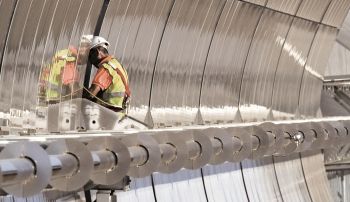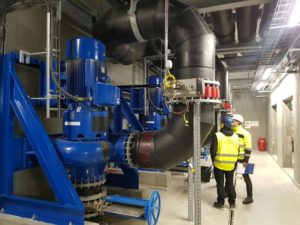Rheinhütte Pumpen Delivers High-Performance Pumps for Challenging Applications in Solar Systems
The Kyoto Agreement of 1997, the Paris Agreement in 2015, nuclear phase-out: climate protection and, as a result, the need for alternative sources are on the agenda worldwide. The energy industry is increasingly placing its focus on renewable energies. Plant manufacturers of solar energy systems are also facing a constant source of new challenges and a continuous demand for innovation in order to be able to serve the growing market.

Renewable energies are on the advance - above all solar energy (Image: Courtesy of paul-langrock.de / Solar Millennium AG)
Since the solar energy sector has become stronger, molten salts have increasingly been used as a heat transfer medium and, above all, as a heat accumulator. With the GVSO, Rheinhütte Pumpen GmbH has developed a pump that meets the requirements of solar systems that use molten salts as a heat transfer medium.
Since the early 1990s, solar energy systems have been part of the global landscape, and the trend is rising. In 2015, more than 250 billion kilowatt hours were generated worldwide from photovoltaics. In addition to oil and gas, new heat transfer media such as molten salts have also been tested over the past twenty years. As the demand for solar energy is constantly growing, the concentrated solar power systems are also being further developed and optimised in order to generate more energy and to use it efficiently. In the meantime, many plant operators rely on thermally highly efficient molten salts as a heat transfer medium. The high temperatures of the medium also pose challenges for pump manufacturers.
Molten salt in solar energy plants
Molten salt is produced when salt is heated above its melting point, which - depending on the salt or salt mixture - occurs at temperatures of between 150 °C and 600 °C. Eutectic mixtures of alkali and alkaline earth salts are excellent substitutes for oil and gas as a heat transfer medium. The reason: molten salt is the only medium that can also be used at temperatures above 400 °C. Even temperatures of up to 600 °C pose no problem. The use of molten salt as a heat transfer medium is definitely an economical alternative and it has been used for thermal transfer since the 1950s. Initially, molten salts were mainly used in chemical plants, for the thermochemical treatment of metals, in hardening processes or for thermochemical cleaning.
There are three sustainable reasons for using molten salts in solar energy systems: good thermal transfer properties, high temperature tolerance and low viscosity. The use of molten salts as a heat transfer medium also presents pump manufacturers with challenges, especially due to the high temperatures that the systems and components must be able to withstand. Reliable and economica pumping is extremely demanding and requires a great deal of know-how in the design of the pumps. The Rheinhütte Pumpen GmbH in Wiesbaden is a specialist for corrosion proof and wear resistant materials and for the construction of highly durable molten salt pumps.
Sturdy, reliable, efficient
Rheinhütte Pumpen specializes in the design of pumps for a wide range of applications which are made of corrosion proof and wear resistant materials. Depending on the application, the company manufactures pumps made of metal, plastic or ceramics. Metal system components have demonstrated their suitability for pumping molten salts. The GVSO, a vertical submerged centrifugal pump, is specially designed for use in solar systems where molten salts serve as a heat transfer medium.
For applications with molten salt temperatures of up to 470 °C, the pump is manufactured from ferritic heat-resistant steel, for higher temperatures, it is made from high-quality austenitic stainless steel. In addition to its high temperature tolerance, the GVSO pump is ideally suited for demanding media such as molten salt and for use in solar systems due to its individual design options. It offers maximum design flexibility: It is available in 38 sizes with single or multi-stage design and can be used with a immersion depth of 0.5 m to 18 m. Up to twelve intermediate bearings are used in long pumps and these are lubricated by the molten salts. Rheinhütte Pumpen always designs the GVSO individually to serve the respective application of the customer. For example, the pump can be adapted to meet the desired pressure temperature conditions (the nominal pressure of the GVSO is up to 40 bar). With regard to the maximum operating depth, the discharge head (up to 200 meters) and the details of the pipeline and tank, Rheinhütte designs the pumps of the GVSO series to customer specifications and to perfectly match the respective application.
Specially designed for use in solar systems
The molten salt absorbs the solar energy in the form of heat and is then temporarily stored in heat storage tanks. There, the vertical centrifugal pump of the GVSO series is used to continue to pump off the heated molten salt, which can reach temperatures of up to 600 °C. Due to the sliding bearing principle, the molten salts also serve as a lubricating medium, which is why, even in intermittend operation, the GVSO has low bearing wear. In solar systems, pumps with a length of at least 14 meter are usually used. The manufacture and integration of such long pumps is a "speciality" of the pump manufacturer Rheinhütte Pumpen. The company develops individual solutions for solar energy systems using molten salts as a heat transfer medium or for heat storage tank.
Source: ITT Rheinhütte Pumpen GmbH







